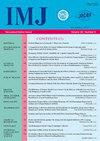ANALYSIS OF CLINICAL AND ANAMNESTIC PARAMETERS IN CHILDREN WITH EPILEPSY OF DIFFERENT AGE GROUPS
Q4 Medicine
引用次数: 0
Abstract
According to epidemiological studies, it has been determined that from 0,5 to 1,0 % of children have epilepsy. As well it is considered as one of the most common chronic neurological diseases of childhood. Epilepsy is a multi−etiological disease, the clinical course of which is characterized by spontaneous uncontrolled functional disorders arising from hypersynchronous electrical discharges in the cerebral cortex. This study was aimed to investigate the features of clinical manifestations and anamnestic data in children of different ages, suffering from different epilepsy forms. We examined 1,017 patients aged from 3 months to 17 years. All patients were assessed for somatic and neurological status, electroencephalography, magnetic resonance imaging of the brain, if necessary the laboratory tests and consulting other specialists were performed. The analysis of findings shows that the most common is symptomatic epilepsy compared to idiopathic and cryptogenic. The prevalence of idiopathic epilepsy increases in early school age and enhances as much as possible in adolescence. In patients with cryptogenic epilepsy, forms with focal onset, generalized and unclassified seizures were identified. Cryptogenic epilepsy was mostly diagnosed in children under 10 years, likely indicating a disruption of physiological connections and morphofunctional immaturity. The symptomatic epilepsy according to the localization of focal disorders was divided into: temporal, frontal, parietal, occipital and multifocal. The major symptoms of epilepsy are observed in primary school and adolescence. In preschool age, the most common is frontal localization of the focus, parietal ; in primary school − temporal, occipital and parietal, in early − multifocal. Etiological factors of symptomatic epilepsy include the CNS congenital malformations, CNS perinatal lesions, traumatic brain injury, neuroinfections etc. Thus, due to the findings we determined the etiological and trigger factors that led to the development of pathological conditions, including epilepsy. Key words: children, epilepsy, clinic, medical history, etiologic and trigger factors.不同年龄组癫痫患儿临床及遗忘参数分析
根据流行病学研究,已确定0.5%至1.0%的儿童患有癫痫。它也被认为是儿童时期最常见的慢性神经系统疾病之一。癫痫是一种多病因疾病,其临床过程以大脑皮层超同步放电引起的自发不受控制的功能紊乱为特征。本研究旨在探讨不同年龄、不同癫痫形式的儿童的临床表现和记忆数据的特点。我们检查了1017名年龄在3个月至17岁之间的患者。所有患者都接受了身体和神经状态、脑电图、大脑磁共振成像的评估,如有必要,还进行了实验室测试和咨询其他专家。对研究结果的分析表明,与特发性和隐性癫痫相比,最常见的是症状性癫痫。特发性癫痫的患病率在学龄早期增加,在青春期尽可能增加。在隐源性癫痫患者中,发现了局灶性发作、全身性发作和未分类发作的形式。隐源性癫痫大多诊断为10岁以下的儿童,这可能表明生理联系中断和形态功能不成熟。症状性癫痫按局灶性病变的定位分为:颞叶、额叶、顶叶、枕叶和多灶。癫痫的主要症状出现在小学和青少年时期。在学龄前,最常见的是额叶局限性病灶、顶叶;小学时为颞叶、枕叶和顶叶,早期为多灶性。症状性癫痫的病因因素包括中枢神经系统先天畸形、中枢神经系统围产期病变、创伤性脑损伤、神经感染等。因此,由于这些发现,我们确定了导致病理状况发展的病因和触发因素,包括癫痫。关键词:儿童、癫痫、临床、病史、病因及诱因。
本文章由计算机程序翻译,如有差异,请以英文原文为准。
求助全文
约1分钟内获得全文
求助全文
来源期刊

International Medical Journal
医学-医学:内科
自引率
0.00%
发文量
21
审稿时长
4-8 weeks
期刊介绍:
The International Medical Journal is intended to provide a multidisciplinary forum for the exchange of ideas and information among professionals concerned with medicine and related disciplines in the world. It is recognized that many other disciplines have an important contribution to make in furthering knowledge of the physical life and mental life and the Editors welcome relevant contributions from them.
The Editors and Publishers wish to encourage a dialogue among the experts from different countries whose diverse cultures afford interesting and challenging alternatives to existing theories and practices. Priority will therefore be given to articles which are oriented to an international perspective. The journal will publish reviews of high quality on contemporary issues, significant clinical studies, and conceptual contributions, as well as serve in the rapid dissemination of important and relevant research findings.
The International Medical Journal (IMJ) was first established in 1994.
 求助内容:
求助内容: 应助结果提醒方式:
应助结果提醒方式:


